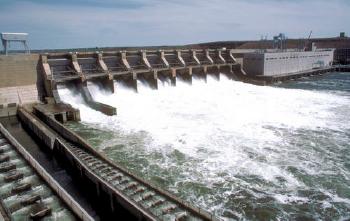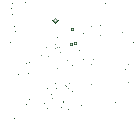~~* The Singing Falls Stream Restoration Project *~~
 ϕ
ϕ
~~* WHEN SALMON ARE DAMMED *~~
~~*Rivers of no Return*~~
Before the coming of settlers to the Northwest, ten to sixteen million salmon and steelhead returned each year to the streams and rivers of the Columbia Basin. The chinook salmon run was once the greatest in the world. Today, runs have declined by 90% to less than 1.5 million fish and about 75% of these fish are hatchery raised.
Some 37 genetically distinct salmon runs have been lost forever. Extinct salmon include the coho of the Snake, Grande Ronde, Yakima, Walla Walla and Bull Run rivers, the sockeye of the Metolius and Wallowa rivers, the fall chinook of the Willamette and Umatilla rivers, and the spring chinook of the Lewis, White Salmon, and Klickitat rivers.
The American Fisheries Society fears that about 36 runs of salmon and steelhead in the Columbia Basin are now at high risk for extinction. The Snake River sockeye, spring/summer chinook and fall chinook salmon have already been listed under the Endangered Species Act.
~~*What's happened to the Salmon*~~

Columbia River Dam
Scientists estimate that about 70%-95% of the human-induced kills of salmon in the Columbia Basin are dam related. According to the U.S. Fish and Wildlife Service "the major decline of the runs coincides with the construction and operation of dams for electrical power, irrigation, and flood control. Between 1930 and the late 1970's about 200 dams, including 19 major hydro-electric dams, were constructed in the Columbia Basin to provide water for irrigation, flood control, barging, and cheap electricity for the aluminum smelters and cities of the region. Hardly any major stream was left untouched. For example, the 1214 mile Columbia River was turned into a series of back to back dams and reservoirs. Less than 200 miles of the Columbia River in the United States remain free-flowing today.
Dams have decimated salmon in many ways including:
#1. Blocking and flooding salmon habitat.
#2. Killing or stunning fish as they pass through dam turbines.
#3 Increasing migration times, predation, and stress.
If salmon are to survive, dams must be modified to increase water flow and provide safer passage. The “other solutions” that have been tried for decades have not worked:
#1. Hatcheries are not able to compensate for dam impacts.
#2. Barging salmon around the dams has not restored the runs.
#3. Severe reductions in commercial and sport fishing have not stopped the decline ( e.g. Idaho has not had a general salmon fishing season since 1978; Columbia River commercial fishing for summer chinook was closed in 1965).
~~*What needs to be done to help Salmon survival?*~~
Some scientists feel that the quickest and simplest way to rebuild Columbia Basin salmon populations is to remodel the dams. The dams must be fixed to allow safer, quicker passage for young migrating salmon. This means:
#1. Screening the dams so young fish are kept away from the turbines.
#2. Spilling more water and more salmon over the dams during migration times, rather than collecting them for barging.
#3. Increasing water velocity during salmon migration. This is most effectively done by temporarily drawing down the water levels in the reservoirs behind the four lower Snake River dams by 30 to 40 feet and by reducing the water level of the John Day reservoir by 5 to 7 feet.
#4. It means modifying the dams to allow for these drawdowns.
Other measures such as water conservation, screening of pumps and diversions, and restoring stream-side habitat are also necessary for salmon survival, but will be insufficient unless the dams are fixed.
~~*What will the changes cost?*~~
It will cost money to fix the dams and to mitigate for the impacts on other users of the river, but it is affordable for the region's rate payers. The required changes will also have little or no net impact on prices or jobs, according to university agricultural economists.
Dam draw-downs will mean spending money to fix the dams to allow for the reservoir reductions, adjusting the fish passage facilities for adult and juvenile fish, and armoring the reservoir embankments. It will also mean paying to relocate irrigation pump intakes and marina docks to deeper water so they can be used during the drawdowns, and compensating barge transporters and some port operators for temporary interruption of their work.
It is estimated that the full costs for facility modifications and river user compensation will raise the average residential electrical bill from $9-$18 per year ($0.75-1.50/month). This increase to household bills could be eased if there was a reduction in some of the energy subsidies to the aluminum industries, which use a fifth of all the power generated in the Northwest. According to a 1994 story in Willamette Week, the average household pays $45 a year to subsidize this industry's electrical rates.
The Northwest Power Planning Council estimates that the loss of firm power due to a 2-month reservoir draw-down will be 25 average megawatts—a minor amount in the total power grid of 16,000 average megawatts. Effects of this loss of power and the associated revenue can be minimized by making power exchange agreements with Southern California and increasing existing programs in energy efficiency.
~~*Why dams kill Salmon*~~
#1. Dams kill salmon because salmon must migrate up and down the river to survive. Salmon are born in the gravel at the bottom of fresh water streams. They grow to a few inches in the streams, then must migrate downstream to the estuaries and out to the sea. They live in the ocean for three to five years, before returning to their home stream to spawn.
#2. Some dams were built with no way for salmon to get either down or upstream. The Grand Coulee Dam blocked 1100 miles of Columbia River habitat. The Hells Canyon Dam blocked another 2,000 miles in the Snake River Basin. Additional spawning habitat was lost when rivers and streams were made into lakes. In total over 30% of the habitat originally available to salmon has been lost.
#3. Scientists generally agree that in the Upper Columbia River Basin dams are responsible for the death of 70-96% of the downstream migrating young fish and about 40% of the upstream migrating adults. Many salmon pass at least 8 major dams on their journey to and from the ocean.
#4. Adult salmon mortality may be due in part to trouble finding and negotiating the fish ladders.
#5. The high death toll for young salmon is caused, in part, by passage through the dam's turbines. Some are killed directly by the turbines; others are stunned and become easy prey.
#6. Young salmon also die because of the dam-caused changes in migration times. Salmon are genetically programmed for a one to two week swim to the sea, swept and shielded by the cold, cloudy, fast-flowing water associated with spring snow melt. Now young salmon may take one to two months trying to find their way downstream in such still water as the 76 mile reservoir behind the John Day dam. The longer the migration in the clearer, warmer water, the higher the loss of salmon to predators such as squawfish. In addition, the salmon may lose the urge to migrate.
#7. The water stored behind the dams turned the arid Columbia Basin into fertile lands through irrigation. That water also allowed cities to grow and prosper. But now, often, too little water is left in the streams of the Columbia Basin for salmon survival. In the John Day River, for example, some areas simply dry up in the summer, killing any fish or salmon eggs present. In other areas, the water gets much hotter than the 68 degrees salmon can tolerate.
#8. Withdrawing water for irrigation and municipal uses can also kill salmon if pumps and canals are not adequately screened to keep fish out. A 1994 study of 53 water pumping sites on Oregon's side of the Columbia River found 80% were not adequately protecting salmon. In one 1992 incident, 44,000 young fall chinook were killed when they were sucked through a pump on the lower Umatilla River and out onto a field; in a similar 1994 incident another unscreened pump killed 45,000 salmon.
~~*What can I do to help the Salmon?*~~
Residents of the Pacific Northwest can help speed the necessary changes in dam structure and operation.
#1. Tell your elected officials that recovering healthy salmon runs in the Columbia Basin is important to you. Tell them you support financial expenditures for dam modification for draw-down and screening and that you are willing to pay more for your electricity. Tell them that the aluminum industry should pay more too.
#2. Conserve electricity. This will reduce the demand for electricity and more water can be released through the dams for salmon. Northwest residents pay the cheapest electrical rates in the country; they pay 1/4 of what people pay in the Northeast. Cheap energy has led to a lot of waste. Despite Oregon's mild climate, households in Oregon use twice as much energy as the national average. Weatherize your home, lower the thermostat, and be conscientious about turning off lights and other items when not in use.
#4. Conserve water to help assure enough is left in the rivers for the salmon. Much municipal and irrigation water is wasted through inefficient systems. Some municipal systems lose up to 20% of their water to leakage. In some areas water use isn't even metered so there is no cost incentive to save. Irrigators can save water too. Farmers in Hermiston were able to reduce their water use by 35% by improving watering techniques and think they can save more by drip irrigation; other may be able to do the same.
stream index
top






